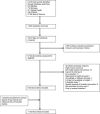Barriers and Facilitators to Integrating Health Service Responses to Intimate Partner Violence in Low- and Middle-Income Countries: A Comparative Health Systems and Service Analysis
- PMID: 28422291
- PMCID: PMC5518204
- DOI: 10.1111/sifp.12021
Barriers and Facilitators to Integrating Health Service Responses to Intimate Partner Violence in Low- and Middle-Income Countries: A Comparative Health Systems and Service Analysis
Abstract
This systematic review synthesizes 11 studies of health-sector responses to intimate partner violence (IPV) in low- and middle-income countries. The services that were most comprehensive and integrated in their responsiveness to IPV were primarily in primary health and antenatal care settings. Findings suggest that the following facilitators are important: availability of clear guidelines, policies, or protocols; management support; intersectoral coordination with clear, accessible on-site and off-site referral options; adequate and trained staff with accepting and empathetic attitudes toward survivors of IPV; initial and ongoing training for health workers; and a supportive and supervised environment in which to enact new IPV protocols. A key characteristic of the most integrated responses was the connection or "linkages" between different individual factors. Irrespective of their service entry point, what emerged as crucial was a connected systems-level response, with all elements implemented in a coordinated manner.
© 2017 The Population Council, Inc.
Similar articles
-
Understanding management and support for domestic violence and abuse within emergency departments: A systematic literature review from 2000-2015.J Clin Nurs. 2017 Dec;26(23-24):4013-4027. doi: 10.1111/jocn.13849. Epub 2017 Sep 29. J Clin Nurs. 2017. PMID: 28403521
-
Factors that influence the provision of intrapartum and postnatal care by skilled birth attendants in low- and middle-income countries: a qualitative evidence synthesis.Cochrane Database Syst Rev. 2017 Nov 17;11(11):CD011558. doi: 10.1002/14651858.CD011558.pub2. Cochrane Database Syst Rev. 2017. PMID: 29148566 Free PMC article.
-
Home treatment for mental health problems: a systematic review.Health Technol Assess. 2001;5(15):1-139. doi: 10.3310/hta5150. Health Technol Assess. 2001. PMID: 11532236
-
Delivery arrangements for health systems in low-income countries: an overview of systematic reviews.Cochrane Database Syst Rev. 2017 Sep 13;9(9):CD011083. doi: 10.1002/14651858.CD011083.pub2. Cochrane Database Syst Rev. 2017. PMID: 28901005 Free PMC article.
-
Surveillance for Violent Deaths - National Violent Death Reporting System, 50 States, the District of Columbia, and Puerto Rico, 2022.MMWR Surveill Summ. 2025 Jun 12;74(5):1-42. doi: 10.15585/mmwr.ss7405a1. MMWR Surveill Summ. 2025. PMID: 40493548 Free PMC article.
Cited by
-
Domestic violence in Mozambique: from policy to practice.BMC Public Health. 2021 Apr 22;21(1):772. doi: 10.1186/s12889-021-10820-x. BMC Public Health. 2021. PMID: 33888119 Free PMC article.
-
The implementation and effectiveness of the one stop centre model for intimate partner and sexual violence in low- and middle-income countries: a systematic review of barriers and enablers.BMJ Glob Health. 2020 Mar 30;5(3):e001883. doi: 10.1136/bmjgh-2019-001883. eCollection 2020. BMJ Glob Health. 2020. PMID: 32337076 Free PMC article.
-
Innovations in implementing a health systems response to violence against women in 3 tertiary hospitals of Maharashtra India: Improving provider capacity and facility readiness.Implement Res Pract. 2022 Jan 6;3:26334895211067988. doi: 10.1177/26334895211067988. eCollection 2022 Jan-Dec. Implement Res Pract. 2022. PMID: 37091087 Free PMC article.
-
Healthcare Providers' Perceptions and Experiences of Training to Respond to Violence against Women: Results from a Qualitative Study.Int J Environ Res Public Health. 2023 Feb 17;20(4):3606. doi: 10.3390/ijerph20043606. Int J Environ Res Public Health. 2023. PMID: 36834300 Free PMC article.
-
Medical mesocosms and cohort differences in victim decisions in spousal violence in Sub-Saharan Africa.Front Sociol. 2025 Aug 7;10:1266401. doi: 10.3389/fsoc.2025.1266401. eCollection 2025. Front Sociol. 2025. PMID: 40852045 Free PMC article.
References
-
- Bair‐Merritt, M.H. et al. 2014. “Primary care–based interventions for intimate partner violence: A systematic review,” American Journal of Preventive Medicine 46(2): 188–194. - PubMed
-
- Bhate‐Deosthali, P. , Ravindran S., and Vindhya U.. 2012. “Addressing domestic violence within health settings: The Dilaasa Model,” Economic and Political Weekly 47: 66–75.
-
- Bott, S. et al. 2010. “Improving the Health Sector Response to Gender Based Violence: A Resource Manual for Health Care Professionals in Developing Countries.” International Planned Parenthood Federation.
Publication types
MeSH terms
LinkOut - more resources
Full Text Sources
Other Literature Sources
Medical


